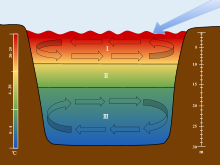
Back Zonering i søer Danish Estratificación de lagos Spanish Veekogu stratifikatsioon Estonian لایهبندی دریاچه Persian Lämpötilakerrostuneisuus (limnologia) Finnish Stratification d'un lac French Srathú teirmeach Irish ריבוד אגמים HE Stratifikasi danau ID Terminė ežerų stratifikacija Lithuanian

I. The Epilimnion
II. The Metalimnion
III. The Hypolimnion
The scales are used to associate each section of the stratification to their corresponding depths and temperatures. The arrow is used to show the movement of wind over the surface of the water which initiates the turnover in the epilimnion and the hypolimnion.
| Lake zones |
|---|
| Lake stratification |
| Lake types |
| See also |
Lake stratification is the tendency of lakes to form separate and distinct thermal layers during warm weather. Typically stratified lakes show three distinct layers: the epilimnion, comprising the top warm layer; the thermocline (or metalimnion), the middle layer, whose depth may change throughout the day; and the colder hypolimnion, extending to the floor of the lake.
Every lake has a set mixing regime that is influenced by lake morphometry and environmental conditions. However, changes to human influences in the form of land use change, increases in temperature, and changes to weather patterns have been shown to alter the timing and intensity of stratification in lakes around the globe.[1][2] Rising air temperatures have the same effect on lake bodies as a physical shift in geographic location, with tropical zones being particularly sensitive.[2][1] These changes can further alter the fish, zooplankton, and phytoplankton community composition, in addition to creating gradients that alter the availability of dissolved oxygen and nutrients.[3][4]

- ^ a b Cite error: The named reference
:0was invoked but never defined (see the help page). - ^ a b Cite error: The named reference
:1was invoked but never defined (see the help page). - ^ Cite error: The named reference
:2was invoked but never defined (see the help page). - ^ Cite error: The named reference
:3was invoked but never defined (see the help page).